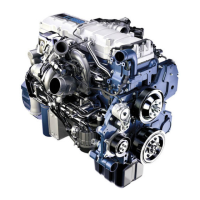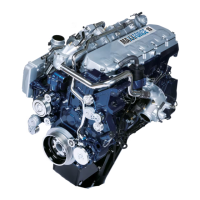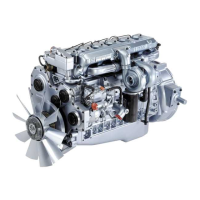TERMINOLOGY 423
Terminology
Accelerator Position Sensor (APS) – A
potentiometer sensor that indicates the position of
the accelerator pedal.
Accessory work – The work per cycle required
to drive engine accessories (normally, only those
essential to engine operation).
Actuator – A device that performs work in response
to an input signal.
Aeration – The entrainment of gas (air or combustion
gas) in the coolant, lubricant, or fuel.
After cooler (Charge Air Cooler) – A heat exchanger
mounted in the charge air path between the
turbocharger and engine intake manifold. The
after cooler reduces the charge air temperature by
transferring heat from the charge air to a cooling
medium (usually air).
Air Management System (AMS) – The AMS controls
and directs air through the intake and exhaust wh
ich
affects engine performance and controls em
issions.
Alternating Current (AC) – An electric curr
ent that
reverses its direction at regularly recur
ring intervals.
Ambient temperature – The environmental ai
r
temperature in which a unit is operating. I
n general,
the temperature is measured in the shade (
no solar
radiation) and represents the air tem
perature for other
engine cooling performance measure
ment purposes.
Air entering the radiator may or may
not be the same
ambient due to possible heating fro
m other sources
or recirculation. (SAE J1004 SEP8
1)
Ampere (amp) – The standard unit fo
r measuring the
strength of an electrical curr
ent. The flow rate of a
charge in a conductor or conduc
ting medium of one
coulomb per second. (SAE J121
3 NOV82)
Analog – A continuously varia
ble voltage.
Analog to digital converter (A
/D) – A circuit in the
ECM processing section tha
t converts an analog
signal (DC or AC) to a usable
digital signal for the
microprocessor.
American Trucking Associa
tion (ATA ) Data l ink –
A serial data link specifie
d by the American Trucking
Association and the SAE.
Acoustic Wave Attenuat
or – A component of the
high-pressure oil rail
designed to reduce hydraulic
fluctuations resultin
g in a decrease of acoustic energy.
Barometric Absolute Pressure (BAP) sensor – A
variable capacitance sensor which, when supplied
with a 5 volt reference signal from the ECM, produces
a linear analog voltage signal indicating atmospheric
pressure.
Boost pressure – 1. Thepressureofthechargeair
leaving the turbocharger.
2. Inlet manifold pressure that is greater than
atmospheric pressure. Obtained by turbocharging.
Bottom Dead Center (BDC) – The lowest position of
the piston during the stroke.
Brake Control Pressure (BCP) sensor – The
BCP sensor is a variable capacitance sensor that
senses the oil pressure in the brake gallery of the
high-pressure oil rail.
Brake Horsepower (bhp) – The power output from
an engine, not the indicated horsepower. The power
output of an engine, sometimes called flywheel
horsepower is less than the indicated horsepower by
the amount of friction horsepower consumed in the
engine.
Brake Horsepower (bhp) net –
Net brake
horsepower is measured with all engine components.
The power of an engine when configured as a fully
equipped engine. (SAE J1349 JUN90)
Calibration – The data values used by the strategy
to solve equations and make decisions. Calibration
values are stored in ROM and put into the processor
during programming to allow the engine to operate
within certain parameters.
Camshaft Position (CMP) sensor – The CMP
sensor is a magnetic pickup sensor which indicates
engine position. Speed is indicated by the number
of vanes counted per revolution of the camshaft.
Camshaft position is indicated by a single position
peg that indicates Cylinder Number 1.
Catalyst – A substance that produces a chemical
reaction without undergoing a chemical change itself.
Catalytic converter – An antipollution device in the
exhaust system that contains a catalyst for chemically
converting some pollutants in the exhaust gases
(carbon monoxide, unburned hydrocarbons, and
oxides of nitrogen) into harmless compounds.
Cavitatio n – A dynamic condition in a fluid system that
forms gas-filled bubbles (cavities) in the fluid.
EGES-265-2
Read all safety instructions in the "Safety Information" section of this manual before doing any procedures.
Follow all warnings, cautions, and notes.
© 2009 Navistar, Inc.

